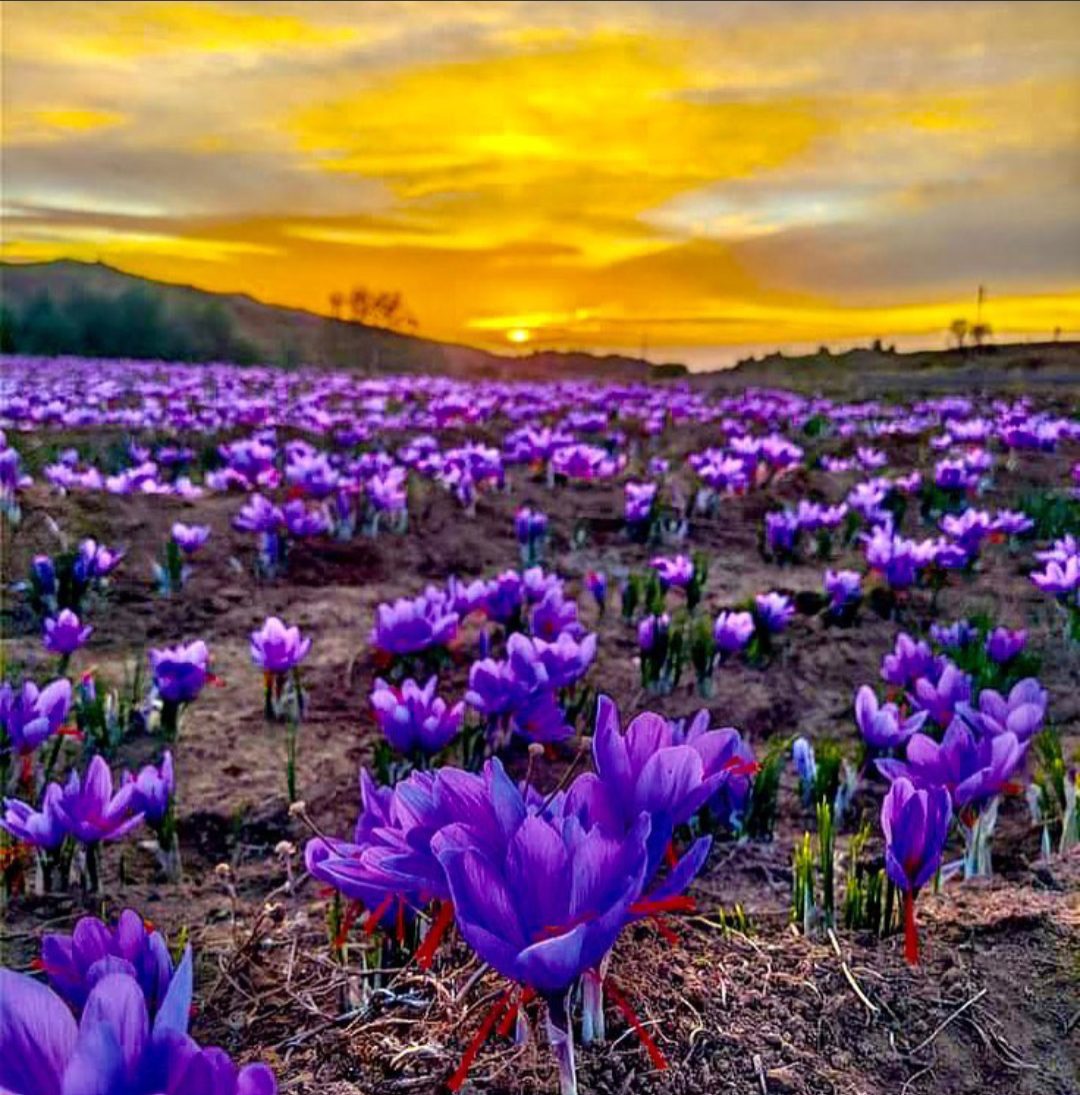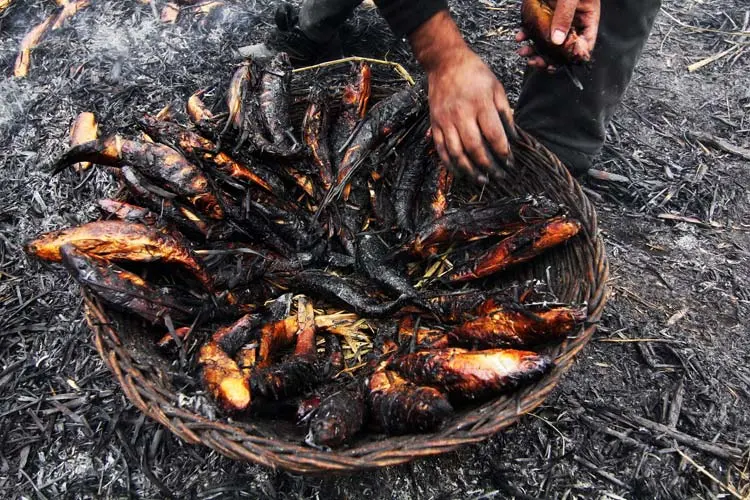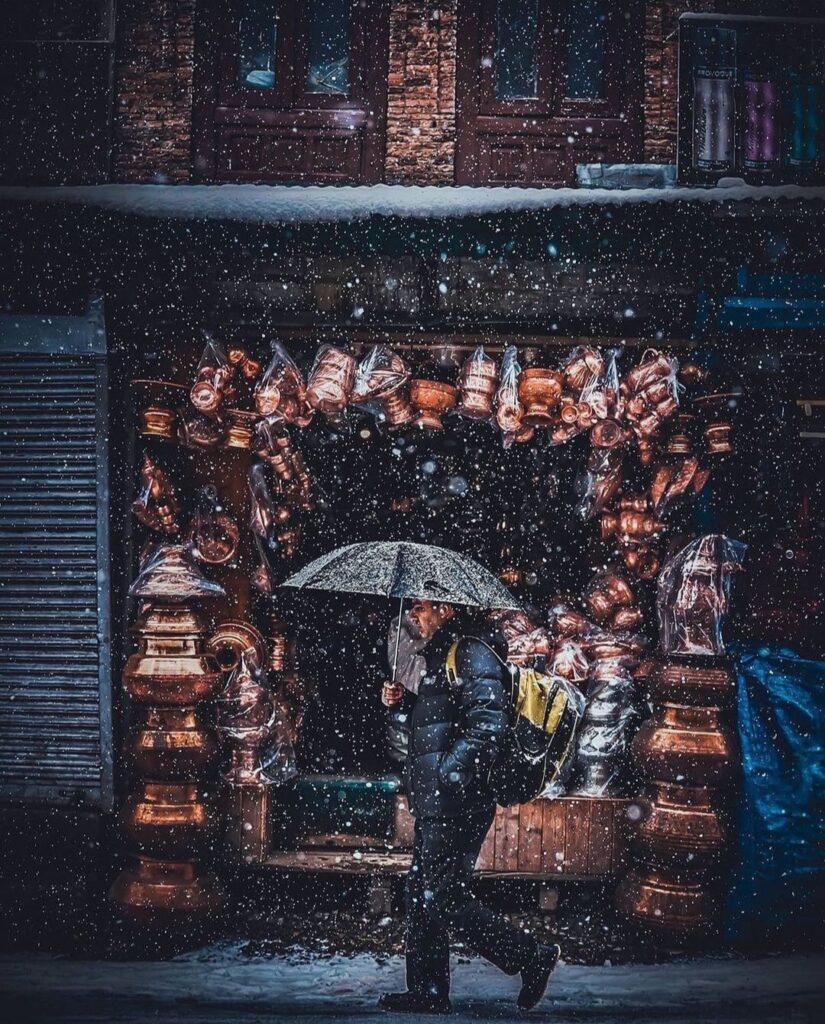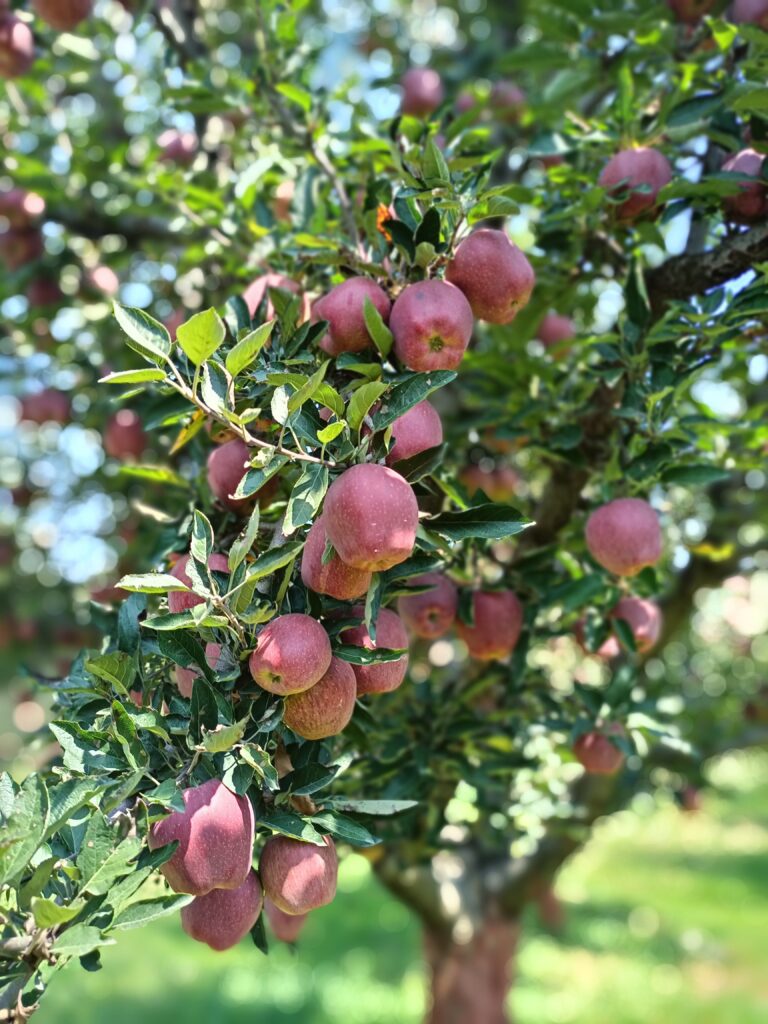In Pampore, Kashmir, fields of purple crocus flowers are encircled by imposing snow-capped mountains. The “Kashmiri Saffron – The Golden Spice of Kashmir”, is made from this bloom. Pampore, a little village 14 kilometers outside of Srinagar, is known as the “saffron capital of India” due to the more than 20,000 households that are actively involved in saffron production there.
The highest quality saffron produced in the region fetches prices of up to Rs 250,000 per kilogramme. The lengthy process of growing it is what drives up the price of the spice. Locals pluck little flowers and collect them in wicker baskets to start the procedure.
Each flower has three parts: petals, yellow strands, and red threads, which are arranged in priority. The red strands are used to extract the pure saffron. For a kilogramme of the red spice, more than 1,50,000 blossoms are sorted and scanned. The strands are then dried over a charcoal fire after that. One of the priciest spices in the world, it is often known as the “crop of gold”.
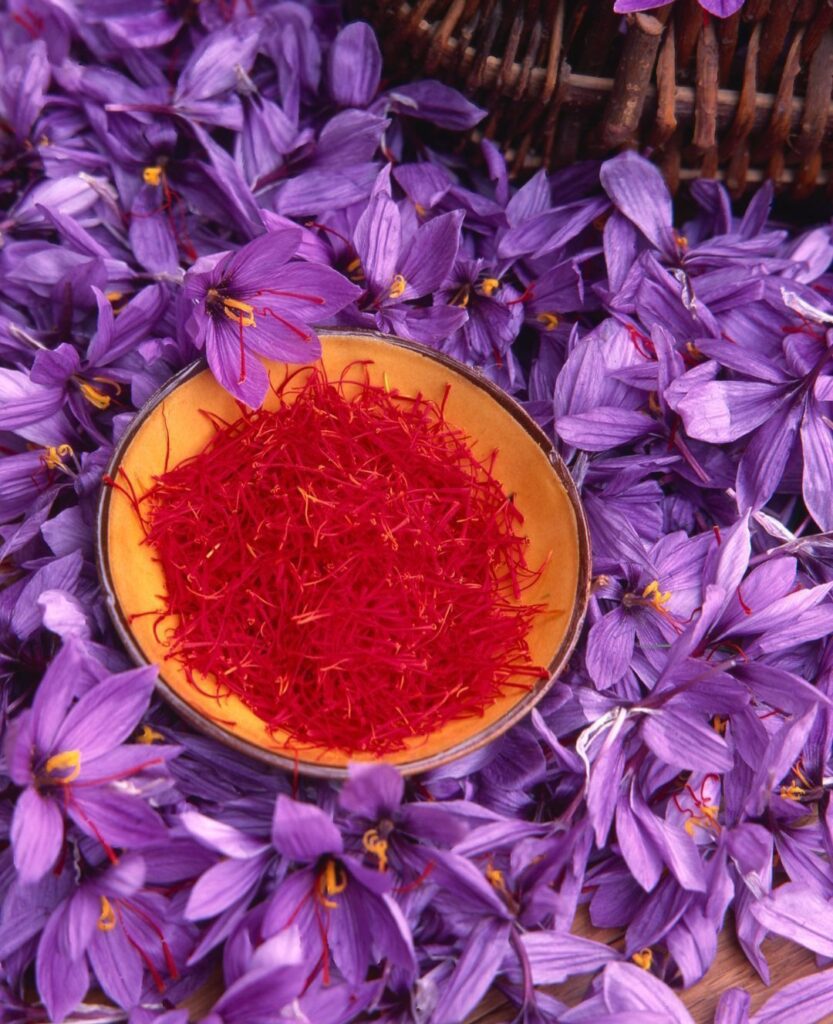

Table of Contents
According to legend, Sufi saints Khwaja Masood Wali and Hazrat Sheikh Sharif-ud-Din brought it to Kashmir. Even the lyrics and hymns of the 16th-century poet Habba Khatoon included these enticing red strands. Habba Khatoon, who was referred to as the Nightingale of Kashmir, was a Pampore native.
Around November is when it is harvested. This is the time of year when visitors from all over the world flock to Pampore to see the meadows’ vibrant yellow, maroon, and purple blossoms.And harvest time resembles a festival for villages in the area. On the first day of the harvest, saffron farmers head to the shrine of Hazrat Sheikh Sharif-ud-Din in Namblabal Pampore to offer some of it.
Although it is used in cooking, it has several health benefits. The oil used to make safranal slows the growth of cancer cells and also has anticonvulsant and depressive properties. Alfa-crocin, a carotenoid, also has a comparable impact. Potassium, manganese, iron, calcium, selenium, copper, zinc, and magnesium are among the minerals that are plentiful in it. It also contains significant amounts of vitamins A and C, riboflavin, folic acid, and niacin.
The government of Jammu and Kashmir hosts a three-day Saffron Festival each year that includes cultural activities. It starts in the final week of October and offers visitors the chance to visit the fields and shop for the spice directly from growers.
In India, this spice is referred to by several other names, such as zafran in Urdu, kesar in Hindi, kong posh in Kashmiri, and kungumapoo in Tamil. Different applications exist for iy. There is kahwa, a Kashmiri saffron-infused green tea. It will make you fall in love with it after only one sip. In a copper samovar, this elixir is carefully brewed with spices like cardamom and cinnamon. The dish is then presented with a hint of honey and frequently topped with almonds. Additionally, it plays a significant role in wazwan, the opulent Kashmiri dinner dish.
► HISTORY OF SAFFRON
Kashmir is considered to be one of the top three regions in the world for cultivating saffron. Historians say saffron or Zafran (as it known in Arabic) has been cultivated in Kashmir since at least 500 BC.
Saffron is said to have its roots in Greece, and the parent type is thought to be wild saffron. For the purpose of growing it, the corm is sown. Lilac to purple are the several color shades of the saffron or Kesar flowers. The stigmata have a vivid red color, while the style is yellow. Three branches can be found on Kesar flowers. Flowers are picked for its scarlet stigma, which is then used to make spices.


Currently, the main saffron-producing nations are Iran, India, Spain and Greece with Iran having the most territory and providing around 88% of global saffron output. In India, 90% of it is produced in Kashmir and here it is mainly confined to Pulwama and Budgam districts. It is the most costly spice in the world and the main ingredient in meals like Kashmiri Rice, Persian Tahchin, and Spanish Paella because of its distinctively complex flavor profile, which is characterised by gourmets as flowery, sweet, spicy, metallic, earthy, and grassy.
► HARVESTING PROCESS OF SAFFRON
The seeds for saffron flowers were planted in rocky, dry soil in August, and they began to sprout in October and November. Hundreds of blooms are manually harvested during the harvest, and workers spend the nights separating the petals from the stigma that contains the saffron.
An earthen clay pot is next used to hold the saffron, which is crucial to the drying process because the pot naturally absorbs moisture without harming the spice. On a wool sheet, it is stretched out to dry for two days in the sun. To get rid of any last bits of stigma or additional husk, the dried saffron is shaken through a strainer before being packaged for sale. The process is repeated several times a week, until the entire crop has been picked and processed.
Kashmir Saffron Fields
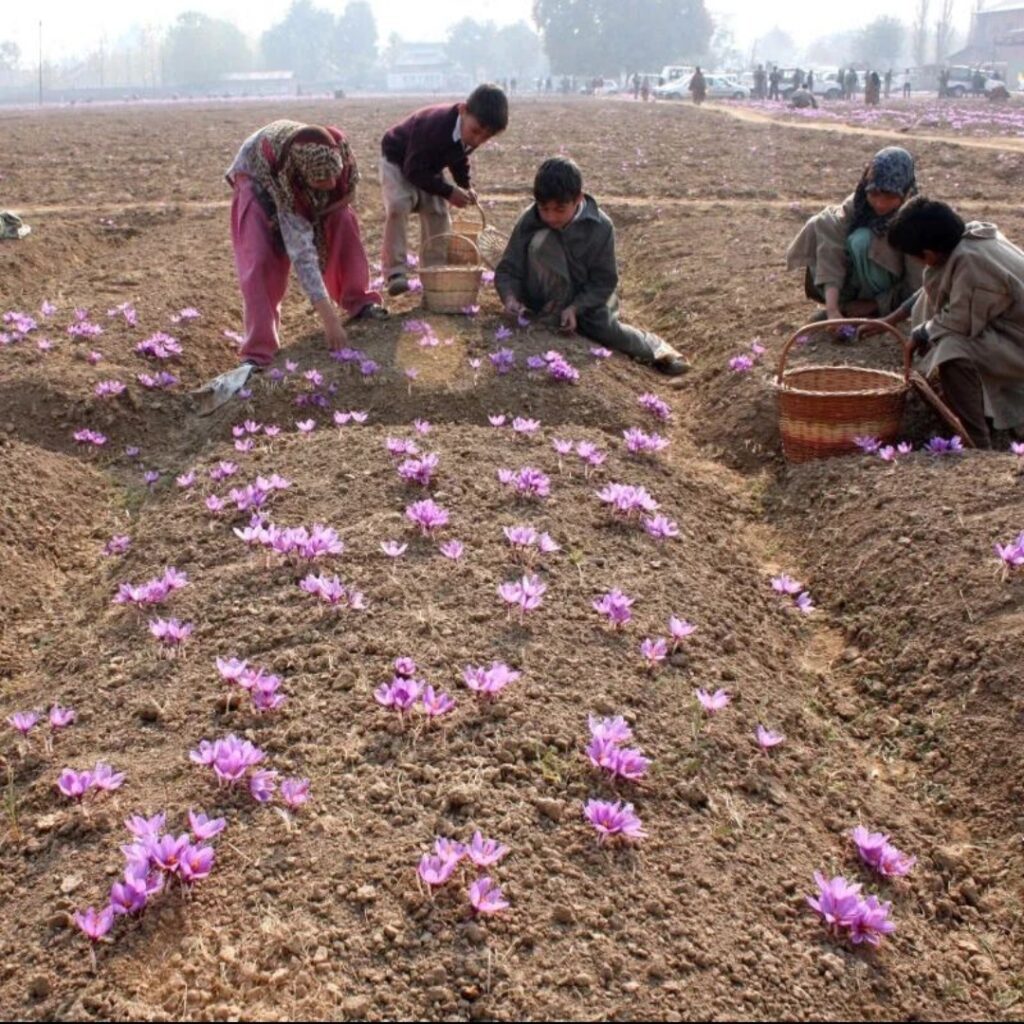

Kashmir Saffron Flower
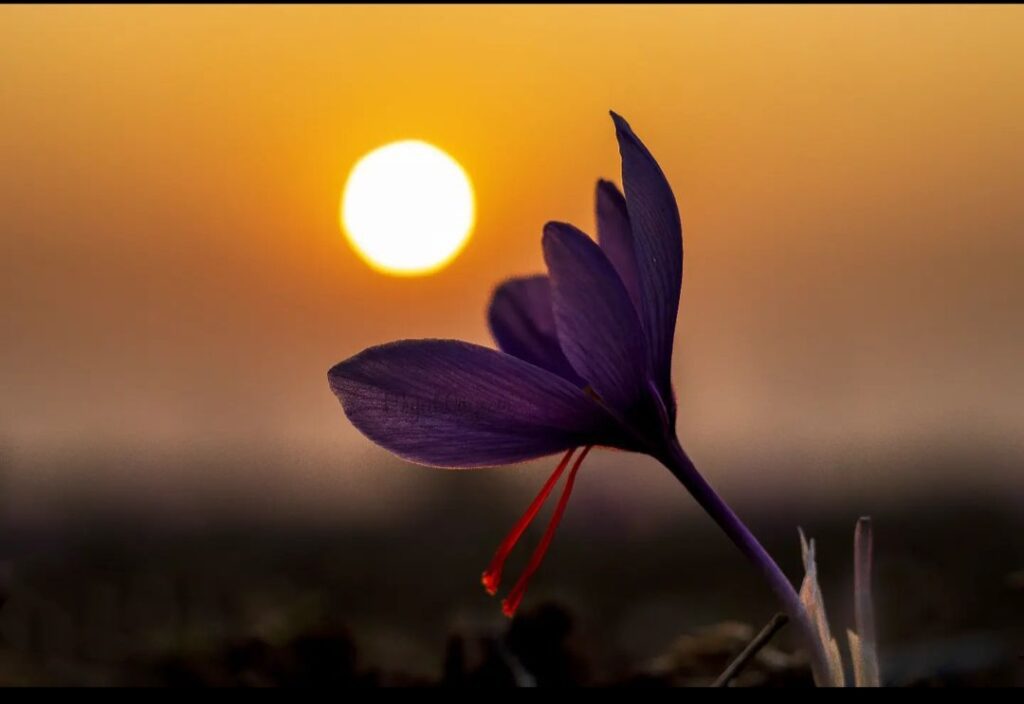

SAFFRON CULTIVATION & LAND PREPARATION
Two to three ploughings are required to prepare the ground for saffron growing. It should be clear of dirt clods, boulders, stones, and remnants of past crops. The soil can become looser, the subsoil can rise to the surface, and fertility can improve with repeated ploughing. Before cultivating the soil, farmyard manure and organic material are also added. Both beds and pits can be used to grow saffron. Pits are excavated that are 10 cm apart from each other and 12–15 cm deep.
IDEAL CONDITIONS FOR SAFFRON CULTIVATION
The most fundamental prerequisite for commercial saffron production is rich soil, which is one of the ideal conditions for saffron cultivation. The climate is the second important component. Long photoperiods and dry, wet soil are required for it.
WATER REQUIREMENT FOR SAFFRON
Compared to other spices, saffron requires less water. The dirt shouldn’t be fully dry, just slightly wet. During the growing season, 283 m cubic of water per acre must be given for irrigation on a weekly basis.
ADAPTED TECHNOLOGIES & KNOWLEDGE SYSTEMS
Growers prepare the corms for fresh planter after digging, followed by sorting and cleaning to revive their saffron production as the distinction of floral and vegetative buds occurs. For longer-term economic benefits, saffron is typically grown in Kashmir in September by planting saffron corms after hand-dropping them into the plough.
In already-existing fields, the soil is ploughed twice, once in June and once in September, to allow for aeration of the corms and the emergence of corm shoots from the soil. During the vegetative period (November to May), saffron fields are monitored for rodent control; in May, dried foliage is picked for use as cattle feed. Under crop rotation, saffron is often followed by linseed, oats, and wheat. However, in some villages, Rajmah/Lentil is also being cultivated.
Also read : Paper Mache in Kashmir.
► VARIETIES OF SAFFRON
Saffron cultivation is done through corms that are underground, compressed stems. There are three different varieties of saffron cultivated in India, especially in Kashmir.
AQUILLA SAFFRON – IRANIAN SAFFRON
The Iranian saffron known as “Aquilla” is grown in the Navelli Valley and the Sardinia region of Italy. The majority of the world’s saffron is produced in Iran. Iranian saffron plants have somewhat shorter flower stalks than Kashmiri saffron plants, which also results in a shorter thread. Iranian saffron is a paler shade of red than Kashmiri saffron.
However, customers hold this saffron’s quality in high respect. This kind of saffron is widely accessible in stores across the world due to its mass production and export. Iranian saffron is more affordable than Kashmiri saffron. High-quality Kashmiri saffron is frequently blended with less expensive Iranian imports and sold in India as pure saffron, a phenomenon that has lost Kashmiri saffron producers money.
CREME SAFFRON – SPANISH SAFFRON
Compared to Iranian and Kashmiri saffron, Spanish saffron is of poorer grade. The United States and other nations utilise this type of saffron the most frequently. This type of saffron is less costly and more potent than other types since it has more yellow components from the plant’s style and more flower debris.
LACHA SAFFRON OR MONGRA SAFFRON – KASHMIRI SAFFRON
The highest grade of saffron, known as Mongra or Mogra, is picked up by hand and has crimson stigmas. The second form of saffron, known as Lacha or Lachha, includes some yellow stigmas mixed in with the red ones. It is the darkest variety of saffron grown worldwide and can be identified by the intense reddish red threads that run through it. Thanks to its potent flavour, perfume, and colouring agent, this kind of saffron is regarded as the greatest saffron in the entire globe. Only Kashmiri soil is used to develop this kind of saffron. Saffron from Kashmir is extremely costly and hardly ever found elsewhere.
► SAFFRON HERITAGE OF KASHMIR
The Kashmir Valley is well-known not just for its breathtaking scenery but also for its premium saffron. The demand for the most costly spice in the world had decreased as a result of COVID-19, one of several causes that have contributed to its drop over time. The best saffron on the market is generally agreed to be Kashmiri saffron. The top three countries for saffron cultivation and exportation are Kashmir, Iran, and Spain. The Kashmir valley produces saffron of the highest grade and with distinctive qualities, because of the lengthy and deep crimson colours. It is an extremely unusual and uncommon spice that demands highly particular growing methods.
The ideal agro-climatic conditions for saffron growing are found in Kashmir. Due to the high concentration of crocin in Kashmiri saffron, which is primarily responsible for its deep colour, it is highly recommended. The distinct scent, characteristics of the stigmas it contains, and the colour of saffron are all indicators of its quality and purity. It is generally accepted that the darker the colour of saffron, the more valuable it is.
The saffron fields should have had irrigation infrastructure put in place to ensure a consistently high yield. Saffron cultivation had been abandoned in favour of other crops by farmers. However, good saffron production was finally observed last year after 25 years because to favourable weather and appropriate rains, and it increased this year. Now, it is anticipated that the production will continue to rise each year and that the farmers’ misery would come to an end.
The government must provide the farmers all the resources they need, including irrigation, in order to revive saffron farming. It is rumoured that the crop is bountiful this year. People are now busily plucking crocus flowers as the first light paints the broad fields a shade of purple. As thousands of people arrive at dawn to manually select saffron threads, the firm still operates as a family-run enterprise. Winter has arrived in Kashmir, as indicated by the purple flower.
Saffron serves as more than simply a symbol of Kashmir’s splendour. These aromatic threads were first used by Sufi saints and have since appeared in Kashmiri poetry and music. Harvest time, which is here, serves as a reminder of the importance of the spice to Kashmiri culture.
Tall, snow-capped mountains surround the purple crocus blooming fields in Pampore, Kashmir. Saffron, a precious spice, is made from this bloom. Pampore, a little village 14 kilometers from Srinagar, is known as the “saffron capital of India” since it has more than 20,000 households involved in saffron growing. The best saffron in the world is farmed there, and a kilograms of it may fetch up to Rs 250,000. The pricey nature of saffron is a result of the labor-intensive growing procedure. The procedure is started by the natives plucking little flowers and collecting them in wicker baskets.
► SAFFRON TRADE IN KASHMIR
The huge undulating Pampore mountains are currently covered in rows of the purple blossoms of saffron, a spice that is used extensively across the nation. Hundreds of family members work together to select the flowers and separate the petals from the stigmas, which are thread-like portions, giving the scene a festive appearance. In J&K, the spice industry employs roughly 30,000 households spread across 226 villages, 90% of which are in Pampore.
The saffron flower collection begins early in the morning. Petal and stick separation will come after it. By doing this, they sundry it until the stigmas take on a specific form. The sight of the deep purple saffron fields may increase the number of tourist destinations, as Kashmir has already welcomed the most visitors this year with 22 lakh. The addition of Pampore will enhance the experience of visitors to Kashmir. Pampore could be a popular destination for those who want to see saffron crops in person. Given the current trend among visitors, this might be a key location for them to capture fun-filled videos for their social media profiles.
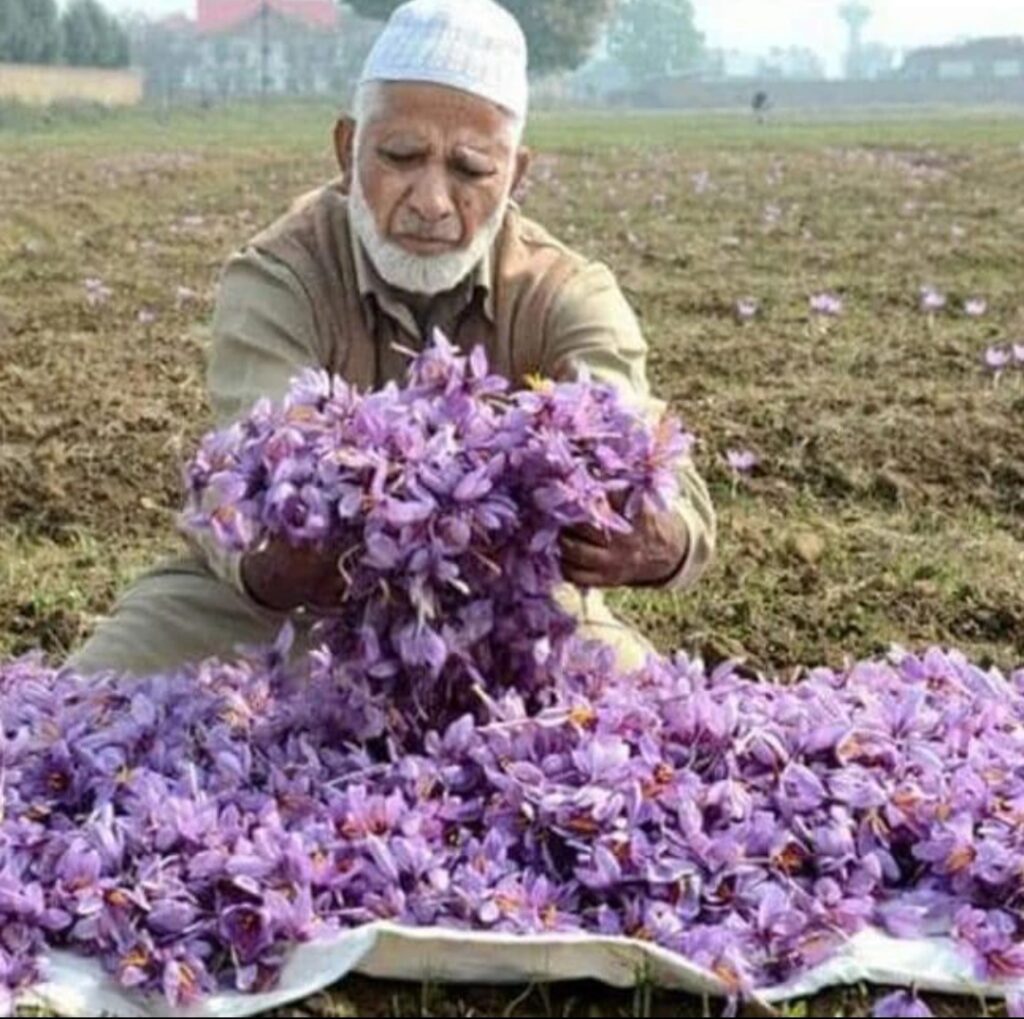

There is expectation this year that the crop would likely experience a 15% rise compared to last year after previously dealing with moisture stress, disease-ridden saffron corms, nutrition depletion, and delayed stigma separation. The area used for saffron growing decreased from around 5707 hectares to 3715 hectares in the past as saffron production decreased. According to data from the agricultural department, productivity had similarly decreased from an average of 3.13 kg per hectare to 1.88 kg by 2010. One of the most expensive spices in the world by weight is saffron. One pound of saffron spice requires around 75,000 saffron blooms, and each kilograms costs between Rs. 2 and Rs. 3 lakh.
► SAFFRON FESTIVAL IN KASHMIR
The Kashmir tourism office organises the Saffron Festival. This event was organised primarily to improve the tourism season in the Kashmir valley on a number of fronts. When advertised heavily, these festivities attract tourists’ attention. Such celebrations promote farmers in producing vast quantities of saffron without depleting the soil and assist saffron producers in marketing their harvest. In the centre of the saffron fields, traditional dances and cultural performances were staged. Saffron grown in Kashmir is of superior quality to that grown in Iran and is known across the world for its production. The main draw in Kashmir’s valley has always been the saffron farms and saffron itself.
Saffron harvesting is well recognised around the world, but it has never been pushed in the Kashmir Valley, where it may be highly beneficial. Visitors are welcome to join the farmers in the saffron harvest. By doing this, farmers make large income, while tourists learn about the skill of saffron harvesting.
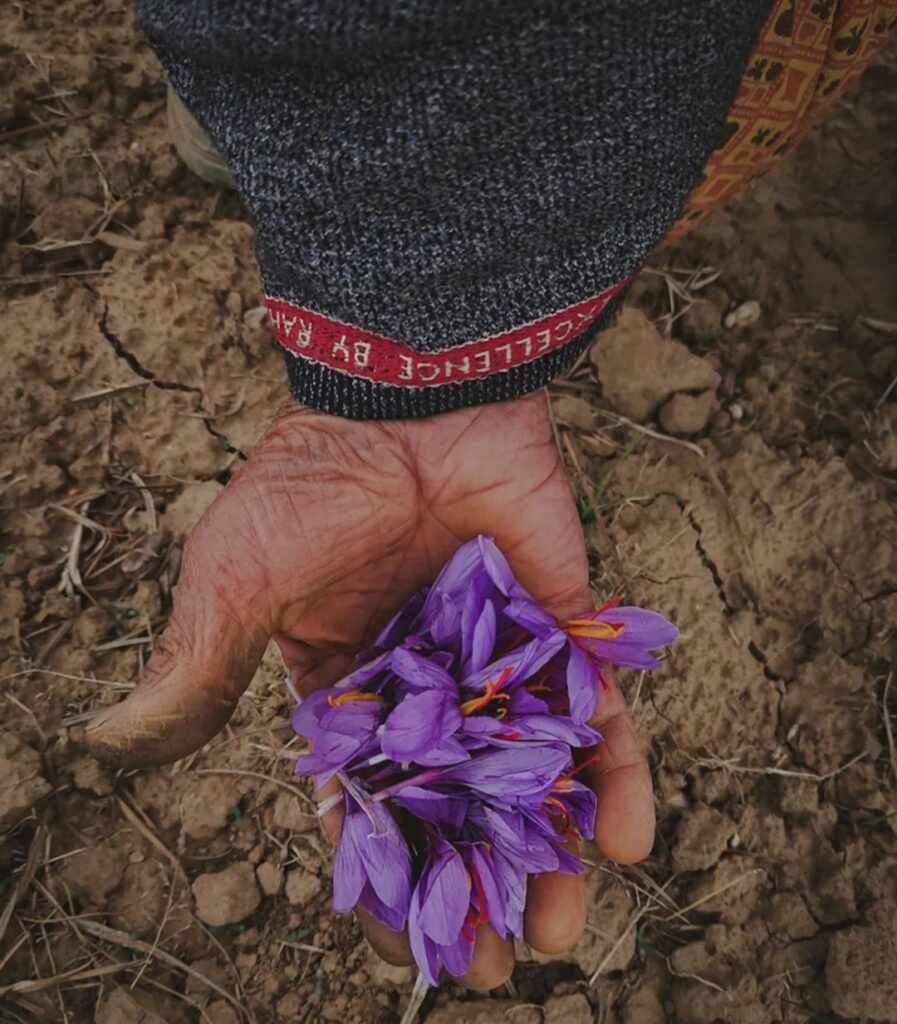

In the months of October and November, saffron blooms. Saffron is one of the most expensive natural products in the world. The Kashmir Valley’s cool climate, good soil, excellent drainage, and abundant natural resources make it the perfect growing region for this spice.
CELEBRATION
The custom of commemorating the harvest of saffron dates back to the time before the Mughals. This event was observed historically when Kashmiri king Yousuf Shah Chak was in charge. After then, the Tourism Department relaunched it. Saffron cultivation is the main source of income for Pampore locals. The entire length and breadth of the Pampore are engaged in the production or commerce of this significant spice, whether directly or indirectly, and their lives revolve on saffron. Pampore has its annual festival of saffron during the first few days of November, when the crop is harvested.
The whole city takes part in cultural events commemorating the reaping of saffron, which include the Kashmiri traditional dances Kud, Bhand, and Dumhal, which are performed with great zeal. The best method to savour the flavour of saffron is to prepare it in “Kahva,” a typical Kashmir Valley tea.
Along with the union of saffron farmers, this eight-day celebration is held in Pampore’s open saffron fields. Saffron is on display and available for purchase at several vendors. This festival is a frequent occurrence and significant event on our Indian calendar. This draws ever more visitors to the Kashmir Valley, especially in the autumn when the saffron fields are at their most beautiful.
LOCATION OF THE SAFFRON FESTIVAL
The town of saffron, Pampore, is where the saffron festival is held in Srinagar, Kashmir. It provides a stunning and unusual view from its perch on the foothills of the Himalayan Mountains.
TIME OF SAFFRON FESTIVAL
The saffron festival is held in November between the last week of October. Recently, to highlight the entire process of saffron growing, the tourist agency had invited students and local farmers to participate in the saffron festival held in the Ladoo region on November 1st, 2022.
Students from South Kashmir’s Pampore on Tuesday highlighted the ongoing saffron harvest to draw tourists for social media reels and unique experiences amidst the elevated tableland known for one of the most expensive spices in the nation by dressing as 16th century Kashmiri poetess and queen Habba Khatoon. The purpose of the event was to highlight the entire process of saffron farming. On this occasion, traditional music was also performed as people were plucking these flowers.
POINTS TO REMEMBER
Between the middle of October and the first week of November, the saffron flowers bloom for about three weeks. It is important to make preparations before travelling to Srinagar for the celebration because it is winter and the Valley experiences extremely low temperatures in the winter.
NO ENTRY FEES
This festival does not charge admission. Everyone from all cultures and beliefs is welcome there.
EFFECTS ON TOURISM
The Valley’s tourism has greatly benefited from the Saffron Festival. Additionally, it provided a reason for visitors to remain longer in Kashmir Valley. The visitors like taking part in the saffron harvest, which brings in a lot of money for the farmers.
Also read : Wood craftsmanship in Kashmir.
► KASHMIR SAFFRON GOT GI TAG
Saffron from Kashmir is well known around the world as a spice that improves health and is used in cosmetics, medicine, and religious rites all over the nation. It has also been linked to conventional Kashmiri cooking and stands for the region’s rich cultural legacy. Products with a specific regional origin and unique attributes and reputation are identified with the GI symbol. Geographical indication contributes to the producers’ total economic wellbeing. The main goal of registering a geographic indication is to seek protection for particular goods produced in a given area of the world in order to encourage the marketers to grow their businesses internationally.
Kashmir Saffron GI Tag Date :
Saffron is cultivated and harvested in the Karewa (highlands) of Jammu and Kashmir and has been assigned Geographical Indication (GI) tag in July 2022 by the Geographical Indications Registry. The spice is grown in Pulwama, Budgam, Kishtwar and Srinagar regions of Jammu & Kashmir.
► PAMPORE – SAFFRON WONDER OF THE WORLD
In Pampore, Kashmir, fields of purple crocus flowers are encircled by imposing snow-capped mountains. The precious spice saffron is made from this bloom. Pampore, a little village 14 kilometres outside of Srinagar, is known as the “saffron capital of India” due to the more than 20,000 households who are actively involved in saffron production there. The best quality saffron produced in the region fetches prices of up to Rs 250,000 per kilogramme. The lengthy process of growing saffron is what drives up the price of the spice. Locals pluck little flowers and collect them in wicker baskets to start the procedure.
Each flower has three parts: petals, yellow strands, and red threads, which are ordered in priority. The red threads are used to extract the pure saffron. For a kilograms of the red spice, more than 1,50,000 blossoms are sorted and scanned. The strands are then dried over a charcoal fire after that. One of the priciest spices in the world, saffron is often known as the “crop of gold.”
► USES & BENEFITS OF KASHMIR SAFFRON
Saffron is primarily used in numerous cuisines to provide colour and flavour. It is also used for curing arthritis, infertility, liver enlargement and fever. Saffron is also used commercially in cosmetic and perfumes. It is also said that saffron added to properly cooked milk consumed by pregnant women might improve the health and appearance of the unborn child.
SAFFRON AS MEDICINE : The little flower that might, saffron, is thought to have a number of therapeutic advantages. After ingesting the spice in capsule form, Alzheimer’s sufferers’ cognitive performance improved. The spice may also help with weight reduction by reducing hunger. Safranal, Picrocrocin, and Crocin are three powerful antioxidants that make saffron so beneficial for medical uses. Mood elevation and oxidative stress reduction are two of the most well researched advantages of saffron extract. The latter is especially critical since it significantly contributes to the development of over 100 different illnesses.
► SAFFRON IN INDIA
This spice is known by a variety of names throughout India, including Zafran in Urdu, Kesar in Hindi, Kong Posh in Kashmiri, and Kungumapoo in Tamil. There are different versions of how the spice arrived in India. Being the most expensive spice, it can grow anywhere in the world. India’s Himachal Pradesh and Kashmir states are where saffron is most often grown. The most challenging aspect of saffron production is harvesting.
The saffron plant requires intense summer heat and dryness as well as intense winter cold. Himachal Pradesh has just recently started to make tiny strides in that regard, whereas Kashmir is unquestionably the leader, if not the only, in saffron cultivation in India. In the state’s Kinnaur, Chamba, Mandi, Kullu, and Kangra districts, saffron growing has just lately started.
Saffron is most frequently used in India to flavor and color milk and milk-based desserts. In addition, it is used as a spice in meat, cheese, mayonnaise, and other foods. They are often used in Mughlai cuisine as a seasoning and flavoring ingredient. In Ayurveda, it is used to treat fever, liver enlargement, arthritis, and infertility.
► GLOBAL IMPORTANCE
Saffron cultivation is typical in the Kashmir region. This plant is mentioned in the 5th century B.C in Kashmiri records and is still part of the agricultural economy. Known over the world, Saffron became a cash crop for farmers resulting of a long traditional heritage. However, Saffron cultivation has been facing severe challenges of sustainability and livelihood security with urgent need to adopt appropriate technologies, to address water scarcity, productivity loss and market volatilities.
FOOD AND LIVELIHOOD SECURITY:
There are other crops grown in the Kashmiri regions besides saffron. First of all, maize is the second-most important staple crop after rice. Pulses and millet are other significant summer crops. The two main spring crops are wheat and barley. The Kashmir valley is home to orchards that grow a variety of temperate fruits, such as almonds, apples, cherries, pears, peaches, and walnuts. Kashmir is known for its rich saffron history more than any other product. Saffron is a cash crop, though.
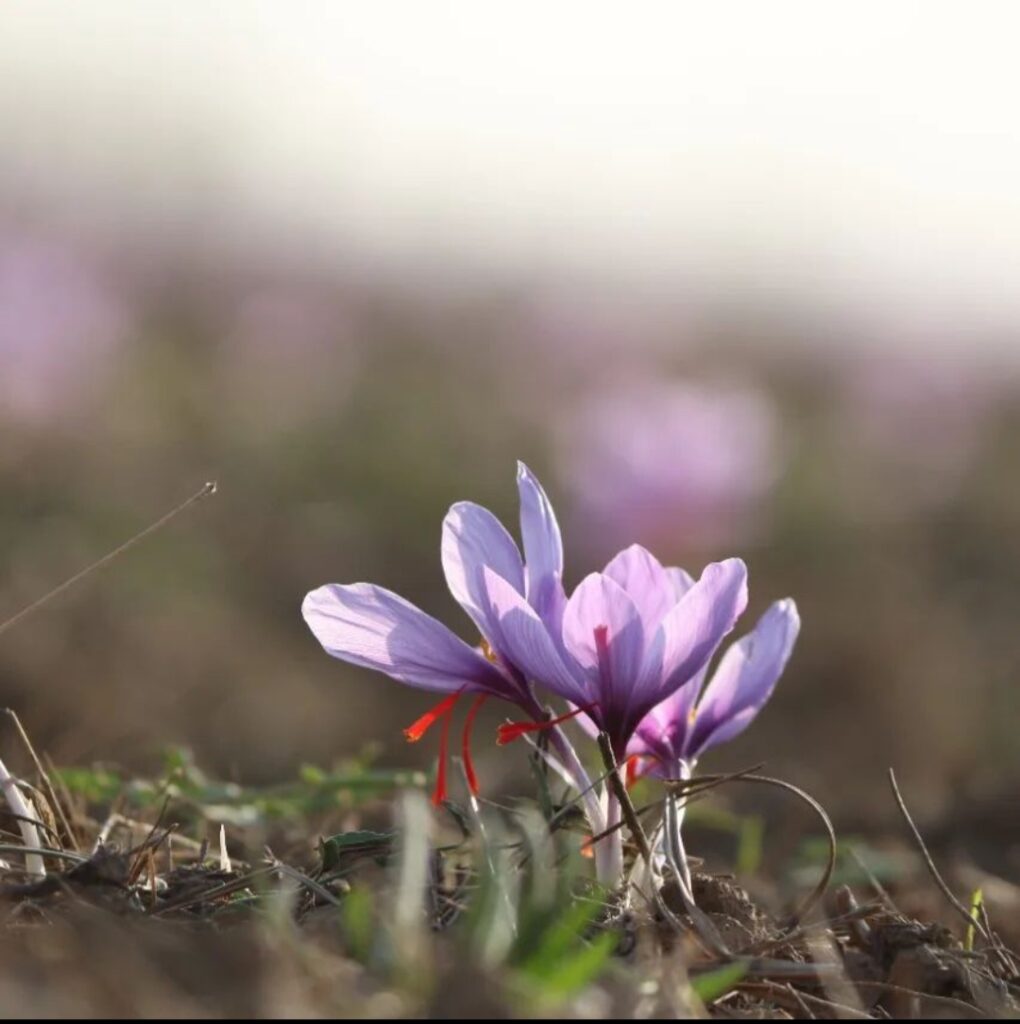

Only 1% of saffron growers are employed in any other form of agriculture, while the other 99% of farmers have other sources of income in addition to farming.
VALUE SYSTEMS, CULTURAL NORMS AND SOCIAL INSTITUTIONS:
According to Kashmiri folklore, saffron is a component of the region’s cultural history; it was introduced there by two sufi ascetics, Khawja Masood Wali. Saffron has long been connected to Kashmir’s renowned cuisine, medicinal properties, and rich cultural legacy. In addition, when ladies sing their traditional songs while plucking the blooms, a lilt of female voices may be heard in the background.
According to the societal structure, Kashmiri women are responsible for the entire saffron tale. Most essential, they pluck and carefully dry the blooms while also tilling the soil. It’s time to give the flowers to the guys once they have been dried, sorted, and thrown away.
ECOSYSTEMS, FUNCTIONS AND DIVERSITY:
The intercropping and agro pastoralism techniques used by Saffron Kashmiri systems encourage a high level of agricultural biodiversity, including Rice, Maize, Millet, Lentils, Wheat, Barley, Almonds, Apples, Cherries, Rape seed, Mustard, Linseed, Sesame, Toria, and Cottonseed. Additionally, in this agricultural method, sheep and goats are produced, giving the soils a source of manure.
Saffron is an unique plant to the region, although it has been threatened with extinction because of its cultivation. Last but not least, farmers do not use artificial pesticides or fertilizers, which is good news for the soils and the wild flora and wildlife.
Also read : Does Copper Engraving Really Live up to the Hype?
► FINEST ONLINE SAFFRON BRANDS IN INDIA
In India, few individuals are able to resist the allure of a Kesar Kulfi falooda served as dessert. Several others also vouch for their favourite Kesar milk or Zafrani pulao. Saffron is known by several names, including Kesar and Zaffran. The magnificent spice saffron is used to create special dishes, especially for ceremonial events. The most common response, however, is I had no idea that saffron was also offered under a brand when asked to list the greatest saffron brands in India.
Saffron is mostly farmed in Kashmir in India. But saffron is also grown in Central Asia, Europe, the US, and China’s Tibetan area. Let’s first examine why saffron is so expensive before learning the finest Indian saffron brands.
BUY KASHMIRI SAFFRON ONLINE
| LION | KASHMIR (INDIA) |
| BABY | KASHMIR (INDIA) |
| KEYNOTE | KASHMIR (INDIA) |
| NOOR | KASHMIR (INDIA) |
| OMNA ORGANIC | KASHMIR (INDIA) |
| THE GATHERING OF SPAIN | SPAIN |
| TAJMAHAL | SPAIN |
| UPAKARMA | AFGHANISTAN |
An overview of the saffron brands
The unorganized sector includes the whole saffron industry. Any unorganized sector will always struggle with finding reliable marketing data. As a result, no pertinent information on saffron is often accessible for study. Based on information from the market, the brands listed below.
LION BRAND
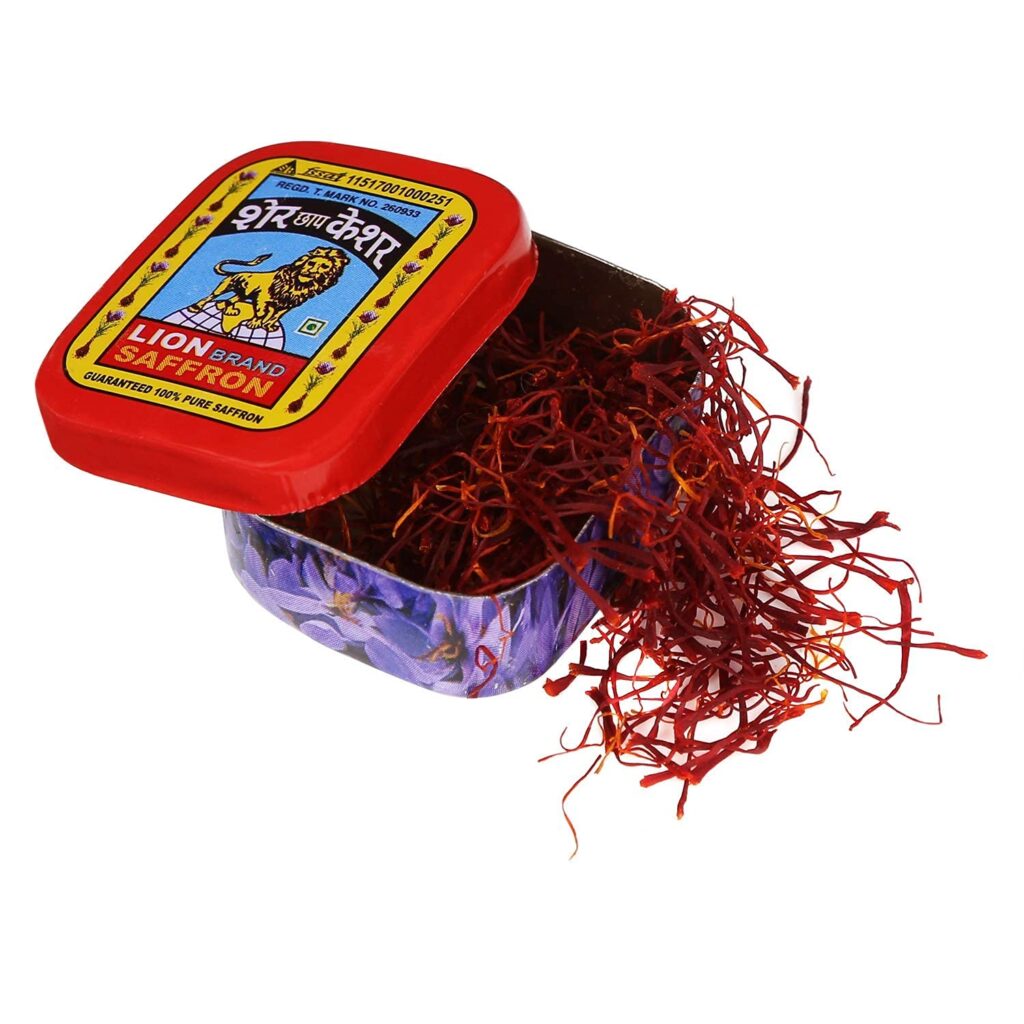

One of the top saffron brands in India is the lion brand, which comes from Kashmir. The product line contains premium, naturally grown saffron. Indian top chefs use Lion brand genuine Kashmir lachaa for its flavour and smell. Lion saffron is packaged in a premium blister container for a long shelf life.
BABY BRAND
Another popular saffron brand from India is the baby brand. Over 175 years ago, the infant brand first appeared in India. It is also renowned for its exceptional quality because to the characteristic deep red colour and yellow interspersed throughout its threads.
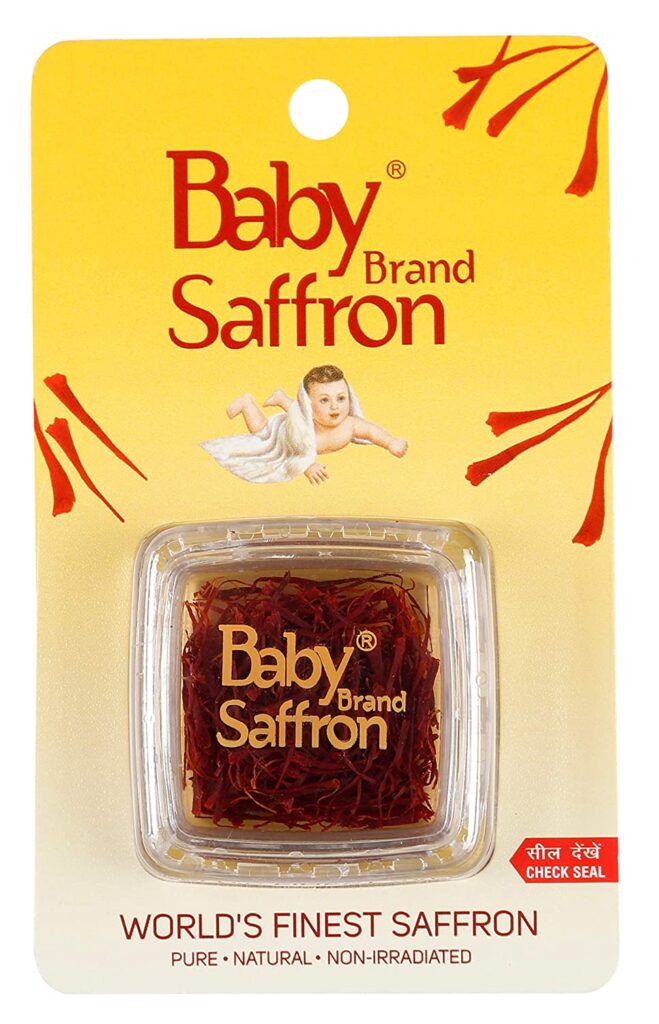

The origin of the brand name is the subject of an intriguing narrative. This producer’s saffron used to be well-known among expectant mothers for its health benefits. The product was subsequently commonly labelled as Baby.
KEYNOTE BRAND
Saffron from the Pampore regions in Kashmir, a brand prized by chefs, is called Keynote. Over the years, the brand has improved its image in European nations, where it is a popular export. Because of the Keynote brand’s distinctive flavour and perfume, confectioners throughout Europe also favour it.
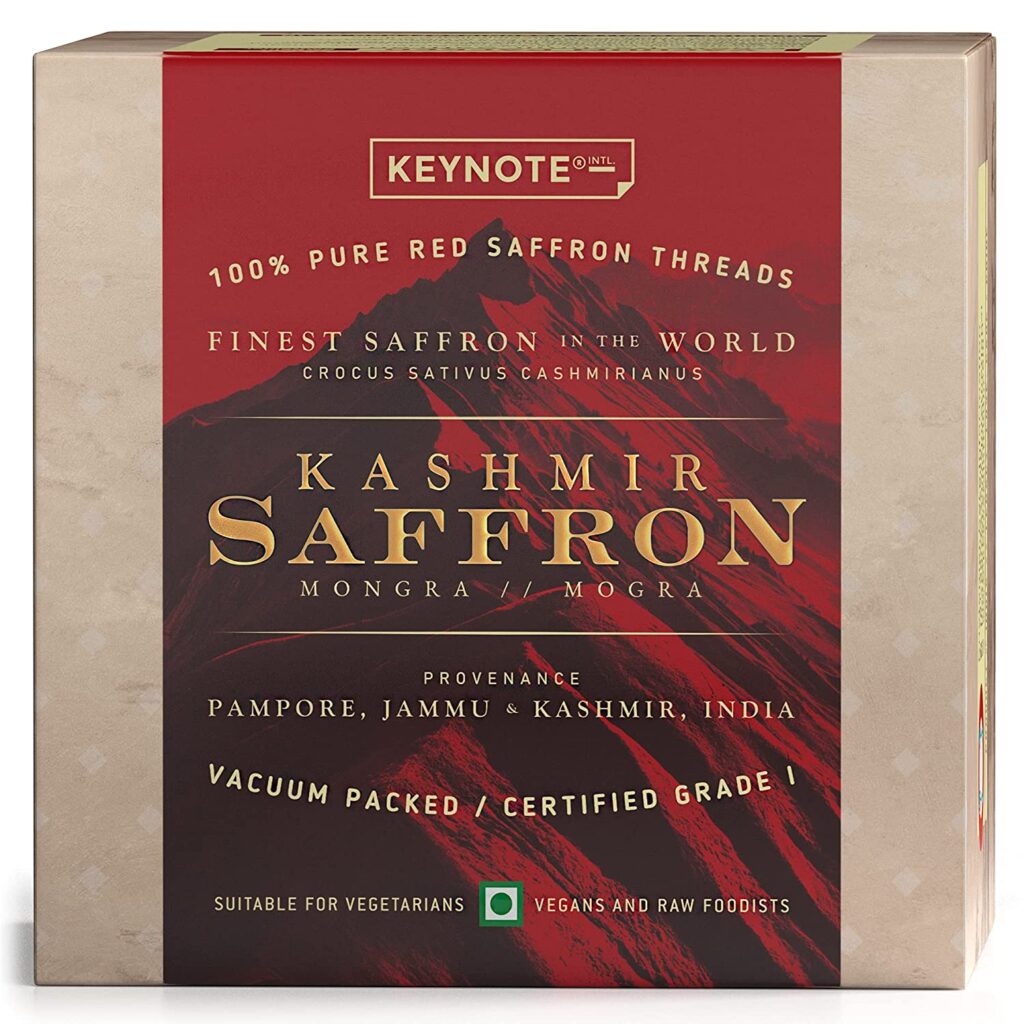

Keynote’s maker took the initiative to switch to better packaging, and the saffron box was replaced with an air-resistant glass pack. As a consequence, the product has received certificates for food safety. Additionally, Keynote saffron’s strong flavour makes it the best option for direct eating with dairy products. The confectioners also favor it.
NOOR BRAND
In the restaurant industry, Noor saffron is the most well-liked saffron brand. Despite being a late entry (1999), Noor has quickly become well-liked thanks to its aggressive price policy and rapid availability.
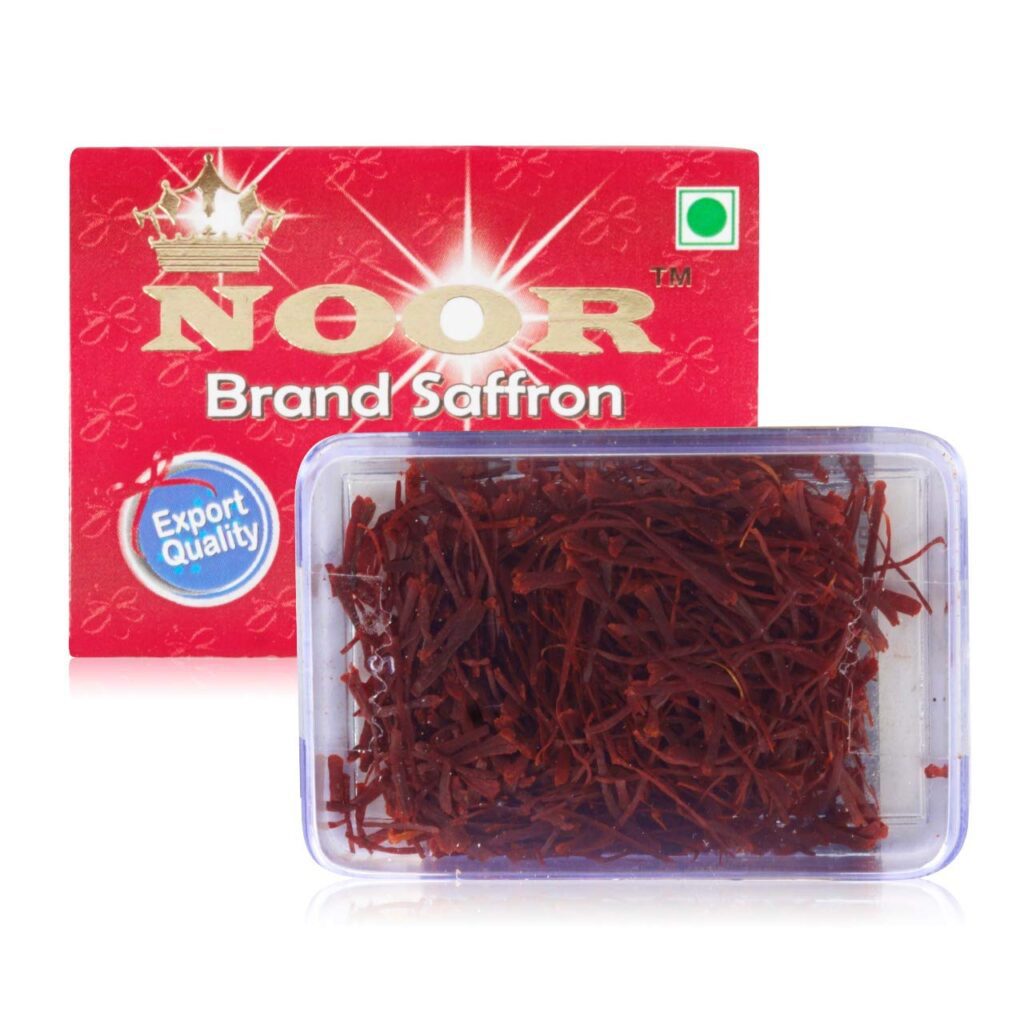

The brand is the perfect addition to a variety of pulao and Biryani meals due to its perfume, rich scent, and pleasant flavour. Noor saffron is hence one of the most popular brands marketed in India.
OMNA ORGANIC BRAND
Omna Saffron is among the best-known saffron producers in India because to its strategic positioning as a clean, organic product. Additionally, the brand has increased sales thanks to competitive pricing. Omni is a top-selling item in the online e-commerce market as a result.
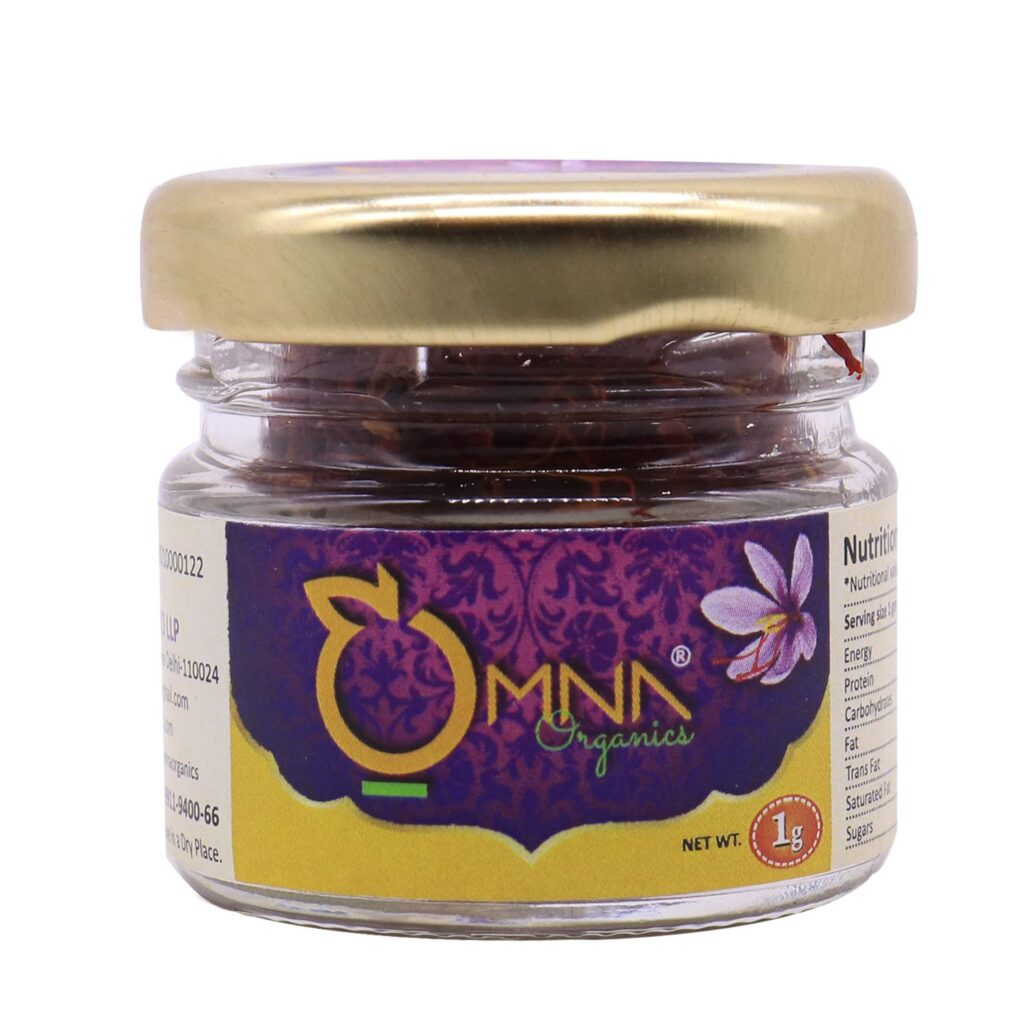

THE GATHERING OF SPAIN
The world’s largest producer of saffron is Spain. The Gathering of Saffron brand is marketed not just in Europe but also in India. The company is recognised as one of the top saffron brands and has a strong market presence in India.
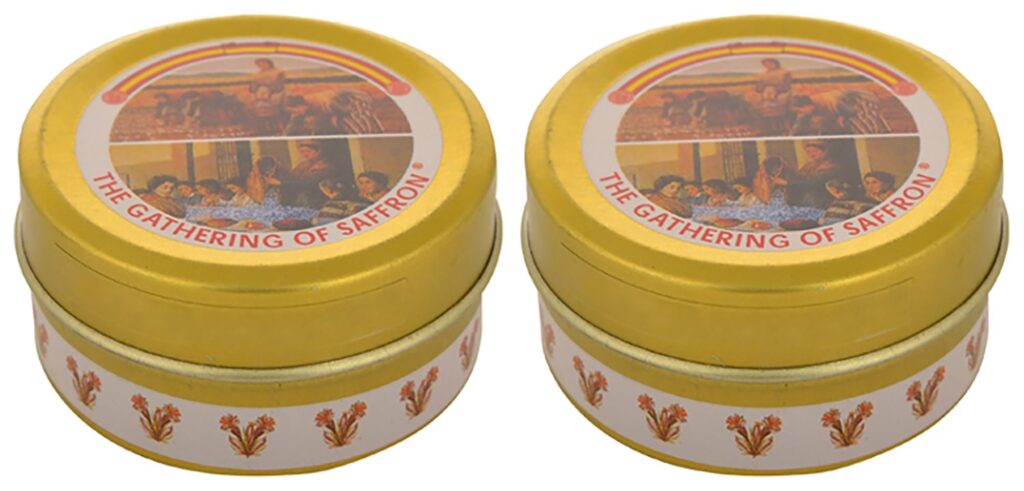

Manufacturers of products under the Gathering of Saffron brand have prioritised producing high-quality packaging that provides total moisture protection. The shelf life of the product has been extended to approximately five years thanks to improved packaging.
TAJMAHAL
You’ll be shocked to learn that the Tajmahal brand saffron is Spanish in origin, just like in a marketing quiz! The company is regarded as one of the greatest saffron brands in India and is known for its distinctive products.
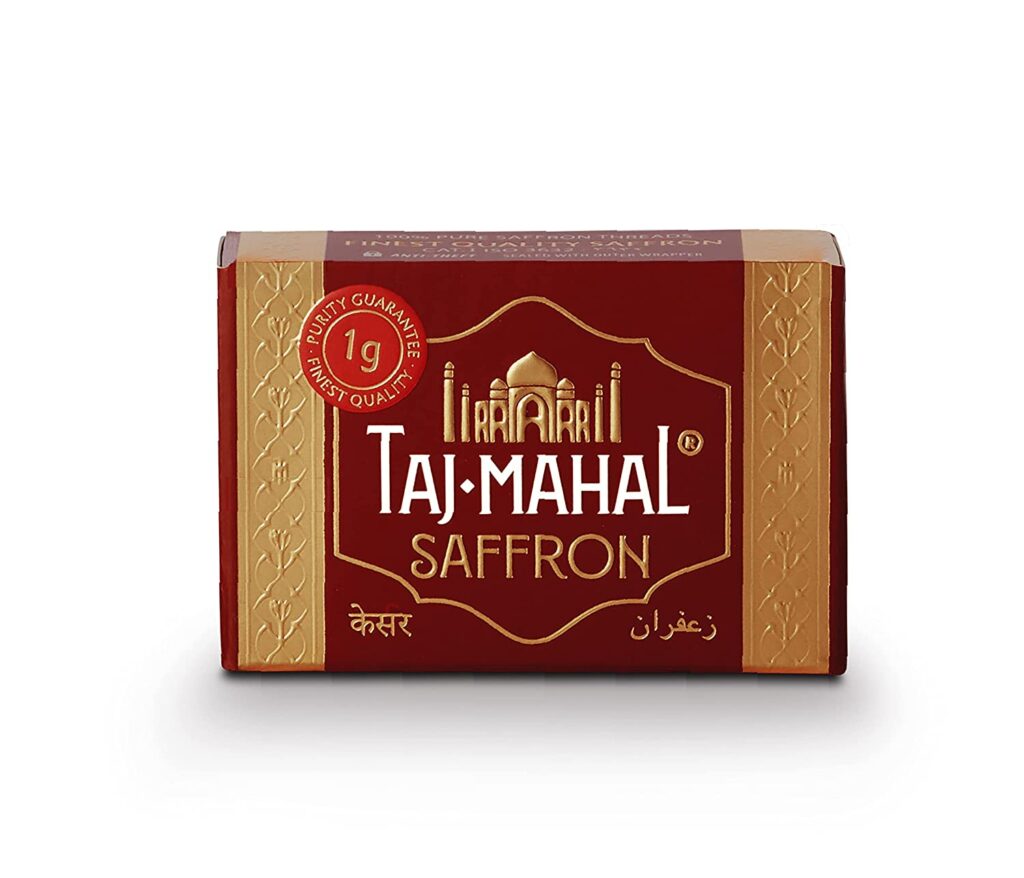

Tajmahal saffron is favoured by customers for its exquisite texture and unusual flavour, and it is said to be safe for even young children to ingest. Additionally, the product may be preserved for a long time with the aid of premium, damp-proof packaging.
UPAKARMA
Afghanistan is the world’s top saffron producer, and the greatest Afghani saffron brand offered in India is UPAKARMA. Due to the product’s vivid red colour, a certain segment of consumers favours it.
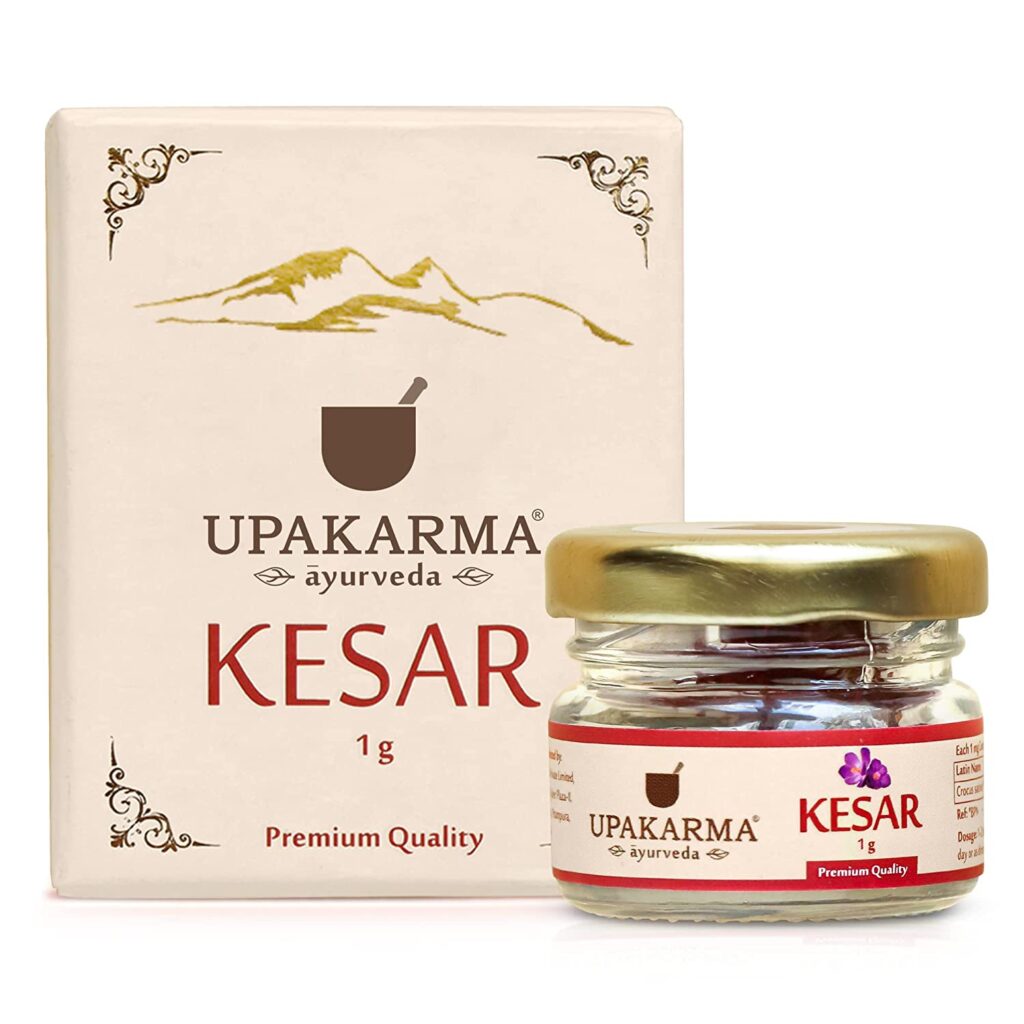

Afghani saffron is mostly recognised for its therapeutic qualities (though not much different from the Indian varieties in reality). It is also well known for its usage in face packs and other cosmetic applications.
KASHMIRI SAFFRON PRICE
Pure Saffron or Kashmiri Kesar is one of the priciest spices available on ‘Earth’. 1 KG Saffron (Kesar) price is around Rs. 3,00,000.
► CONCLUSION
Saffron use has a long and colourful history in the Kashmir Valley. However, due to a number of natural circumstances, such as drought and a lack of irrigation, Kashmir has recently witnessed a fall in the production of valued saffron. Climate change has caused the soil to become dry and unsuited for agricultural growth. Iranian saffron has also arrived in the region, and because of its low cost, it is usually marketed as such.
Thousands of people are still employed in Kashmir by the saffron industry despite all the challenges and hardships. To revive the industry and bring it back to its former grandeur, the government is pursuing a number of actions. The national government started the National Saffron Mission in 2010 to revive the valley’s production of the most costly spice in the world.
FAQS ABOUT KASHMIRI SAFFRON
What is saffron good for?
A potent spice with lots of antioxidants is saffron. It has been connected to health advantages like increased weight reduction and lessened PMS symptoms, as well as better mood, libido, and sexual performance. The best part is that adding it to your diet is simple and typically safe for most individuals.
Why is Saffron so costly?
One pound of saffron spice requires 75,000 saffron flowers since only a little portion of the blossom is actually utilised. Due to the limited amount of saffron spice produced per plant and the labor-intensive hand harvesting process, saffron is quite costly.
Why is Kashmir Saffron the best?
Since Kashmiri saffron contains a lot of crocin, it is regarded as being of the greatest grade. Saffron derives its colour and therapeutic benefits from crocin. Crocin content in Kashmiri saffron is 8.72%, but Iranian saffron has a crocin content of 6.82%.
Is Kashmir famous for Saffron?
Due to its extremely high crocin and safranal content, Kashmiri saffron is well-known around the world. There are three sorts of saffron: Mongra, the most costly and finest; Lacha, the second most expensive and purest; and Zarda, the tail section, which is the least expensive.
How do you eat saffron?
It tastes sweet and flowery when consumed. It tastes complex and subtle, earthy. Contrarily, saffron that tastes metallic, harsh, or plastic-like is frequently a poor imitation of this special spice and ought to be avoided.
What does Saffron taste like?
The flavour of saffron is sweet and flowery. It tastes rich and subtle, with an earthy undertone. Saffron that tastes metallic, bitter, or plastic-like, on the other hand, is typically a sign of a poor imitation of this special spice and need to be avoided.
Does Saffron have side effects?
For the majority of people, short-term saffron supplement use looks harmless. Anxiety, altered appetite, upset stomach, drowsiness, and headaches are possible adverse effects. It might be dangerous to use saffron for extended periods of time or in excessive amounts. Saffron can cause allergies in certain people.
Which saffron is best?
Kashmiri Saffron alone has a distinguishing feature of long stigmas with thick heads making it “Worlds Best Saffron”. The price of Kashmiri Saffron is fairly higher than Iranian Saffron, possibly due to shorter style and stigma in Kashmiri saffron.
Is it good to take saffron daily?
Saffron is possibly safe when taken as a medicine in doses up to 100 mg daily for up to 26 weeks. Some common side effects include drowsiness, stomach problems, and nausea or vomiting. Allergic reactions are also possible. Taking large amounts of saffron by mouth is possibly unsafe.
Is Saffron safe for the heart?
From saffron’s cholesterol lowering benefits to its anti-inflammatory properties, saffron is a spice that is truly good for your heart.
What are the benefits of Kashmiri Saffron?
- A powerful antioxidant. Saffron contains an impressive variety of plant compounds. …
- May improve mood and treat depressive symptoms. …
- May have cancer-fighting properties. …
- May reduce PMS symptoms. …
- May act as an aphrodisiac. …
- May reduce appetite and aid weight loss. …
- Easy to add to your diet and many more
Is Kashmiri saffron the best?
Kashmiri saffron is considered to be one of the finest quality all around the world because of high amount of crocin in it.
What is the price of 1 Kg of Kashmiri saffron?
Pure Saffron or Kashmiri Kesar is one of the priciest spices available on ‘Earth’. 1 KG Saffron (Kesar) price is around Rs. 3,00,000.
When does Kashmir saffron got GI tag?
Kashmiri saffron got GI tag in July 2022
Is Kashmiri saffron available online?
Yes, it is available on many ecommerce websites. But we suggest Amazon because it sells the finest quality.
Where to buy saffron in Kashmir?
There are many shops and businesses selling saffron in Kashmir. But we recommend buying from Pampore, which lies on the national highway. Pampore is the place where saffron is cultivated, so its better to buy from the native place itself.
How do I know my saffron is pure?
Rub the threads with two fingers back and forth a few times. Pure Saffron threads will not break apart, whereas fake saffron will fall apart or turn to dust or liquid.
Which saffron is best in India?
Some of the Best Saffron Brands in India
- Lion – India(Kashmir)
- Baby – India(Kashmir)
- Keynote – India(Kashmir)
- Noor – India(Kashmir)
- Omna Organic – India(Kashmir)
- The Gathering of Spain – (Spain)
- Tajmahal. Spain.
How much is the cheapest saffron?
It is almost 500 Indian Rupees, but remember it wont be purest form.
Does real saffron float or soak?
Another test of real Saffron is the Float Test that real saffron threads do not drown when put in water. They would rather float. Fake Saffron threads would partially or completely submerge in water because of the heaviness of the colored dye or the floral wastage on them.
Is saffron worth more than gold?
Yes, Saffron (Crocus sativa) is a spice that is worth more than its weight in gold.
What is the most expensive spice on earth?
Saffron is by far the most expensive spice in existence right now. Saffron threads are made from the dried stigmas of the saffron crocus plant. Depending on the quality, saffron costs between 3,000 and 14,000 euros per kilo.
Can I store saffron in fridge?
Fridge can only maintain the qualities of saffron for some time, which is said to be 2 weeks.

